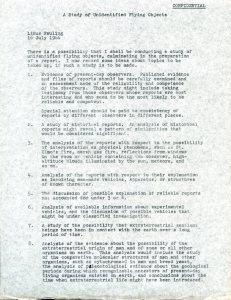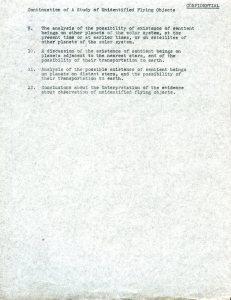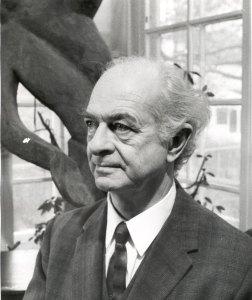
[Part 5 of 6 in a series examining Pauling’s association with the Center for the Study of Democratic Institutions]
Linus Pauling is often remembered for his achievements in chemistry and his active involvement in the peace movement. Much of his work stemmed from an interest in further understanding the natural world and using this knowledge to promote the well-being of others.
It therefore comes as something of a surprise that, during his stint at the Center for the Study of Democratic Institutions (CSDI), he considered taking time to research unidentified flying objects. The phenomenon would seem like an unusual subject for Pauling to study, especially because he joined the CSDI in hopes of focusing on medical chemistry and socio-economic theory. In July 1966, however, Pauling did indeed write a project proposal outlining a program of research on unidentified flying objects.

Pauling’s UFO project proposal, pg. 1. July 1966.

UFO proposal, pg. 2.
In discussing this moment in Pauling’s career, it is important to point out that Pauling viewed the study as a “possibility,” rather than anything close to an immediate priority. One hastens to add as well that the study was not ever conducted. The proposal document that he crafted, however, is evidence of the approach that Pauling would have taken to explain the phenomenon, and it is an interesting document to explore.
As a scientist and citizen, Pauling believed that it was his duty to inform the public about advances in scientific understanding, but slowly, by dint of his institutional arrangement, he found himself growing gradually more distant from the scientific community. After publishing a few papers on nuclear physics and medical chemistry, and engaging in much discussion on world peace, Pauling found himself in a difficult situation: just a couple years after leaving Caltech, his home base for forty-one years, he was becoming increasingly dissatisfied with the CSDI.
The center’s lack of capacity to support scientific research, combined with the paucity of conclusions emerging from the center’s peace discussions, gradually increased Pauling’s appetite for new exploration. The scientific research that he could do on his own, without facilities or funding, was very limited. And in terms of politics and peace, the center was mostly engaged in theory; there was no specific cause for which it was fighting. And so it was that Pauling spent some time at his ranch in Big Sur brainstorming ideas on what to do with his time; researching UFOs was perhaps the most unorthodox notion to emerge from this period of reflection.

Linus Pauling, 1966.
Pauling was quite familiar with reports of unidentified flying objects. Scattered among the many letters that he received each day were a handful asking questions about strange noises in the night and films of white dust appearing in the hills. He also heard rumors about a UFO landing in Santa Fe. Being a long-running fan of science fiction himself, and feeling a duty to communicate scientific knowledge to the public, it is easy to see how Pauling could find importance in addressing the matter in a formal way.
Pauling’s 1966 research proposal, titled “A Study of Unidentified Flying Objects,” was divided into twelve main points. In each point, Pauling stated his intent to study everything from the authenticity and potential explanations of various reports, to the possibility of an extraterrestrial origin of human life. The proposal’s twelve points are suggestive of an ambitious project that would have required Pauling to tap into the fields of evolutionary biology, psychology and history, among others. But it is clear that Pauling’s intent for his study of UFOs was not to perform a scientific investigation of the phenomenon, but to discern and provide facts regarding reports of sightings and ideas about extraterrestrial interactions with human beings.
Pauling’s interest in the subject was not limited to the 1966 proposal. As late as 1968, Pauling wrote to Stirling Colgate, a physicist who was then President of the New Mexico Institute of Mining and Technology, and inquired into an alleged siting of a flying saucer on the school’s campus. The correspondence reveals that the siting was a hoax, perpetrated by a New Mexico Tech student, but Pauling’s interest is indication that UFOs remained on his mind at least a couple of years after he drafted his proposal document.
It can be argued that Pauling’s seemingly abrupt interest in UFOs was an outgrowth of his experience at the CSDI. For much of his time at the center, it is clear that he was engaged in an intellectual quest to discover a way to use his talents for the benefit of the public. To his dissatisfaction, Pauling was unable to find exactly what he was looking for in Santa Barbara, and after three and a half years there, he began actively seeking out a new institutional home.
The time period, however, also stands as evidence of Pauling’s creativity in working in an environment with limited resources. Though the UFO work never got off the ground, Pauling continued to pick up his pencil and slide rule and to research the natural world to the best of his abilities. As a result, several publications resulted from this period of quiet investigation spent far afield from the scientific mainstream.
